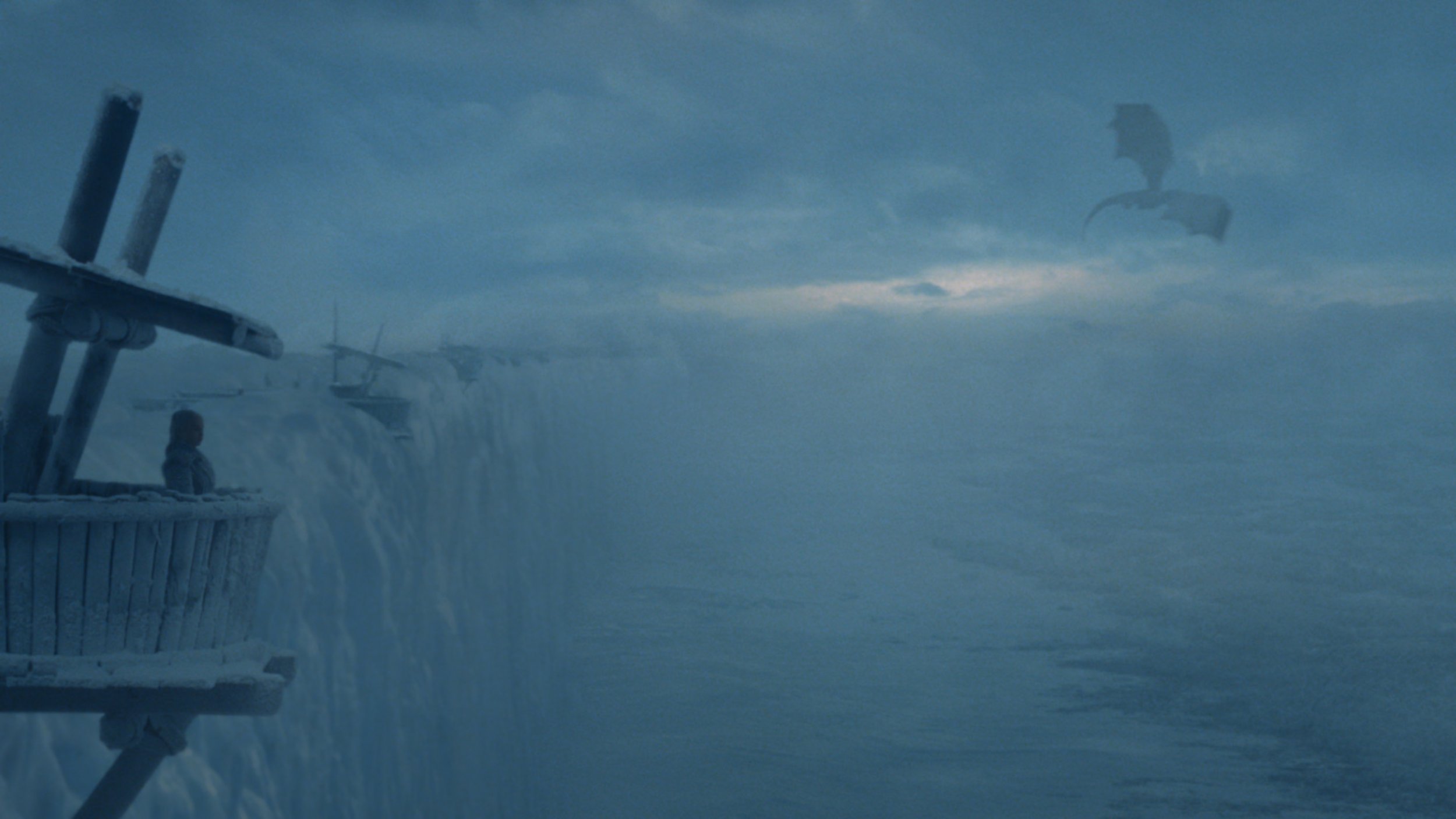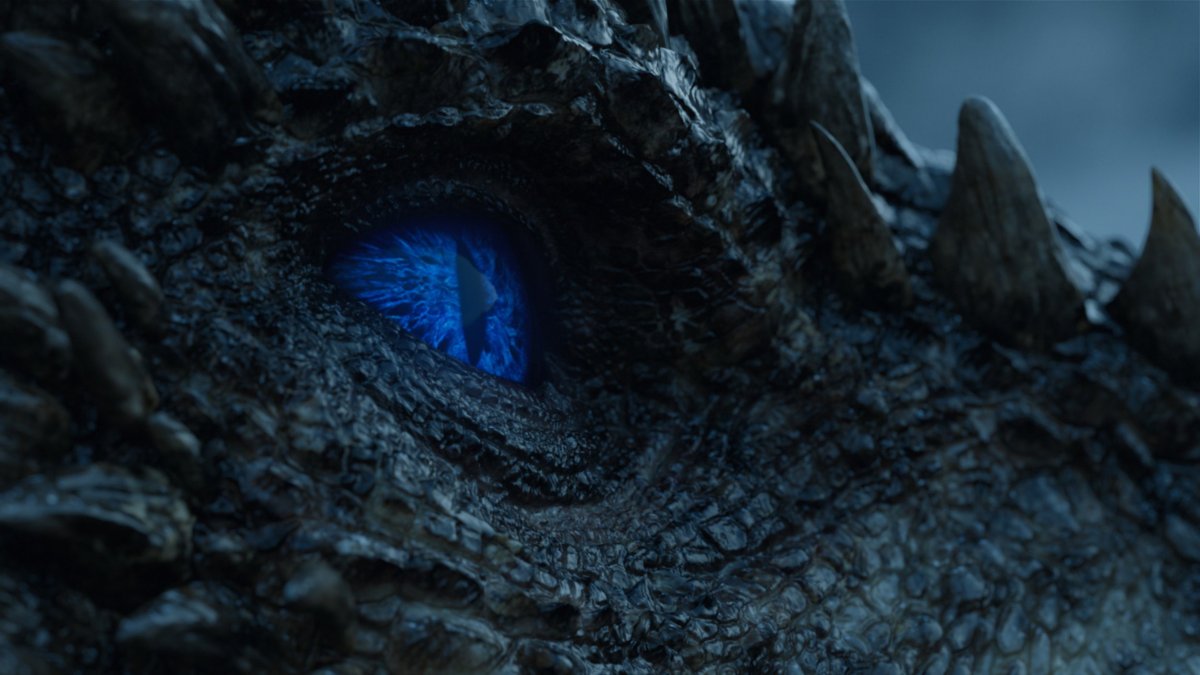
This story contains spoilers about "Beyond the Wall," the latest episode of Game of Thrones. If you don't want plotlines spoiled, click away now.
Have you picked your jaws up off the floor yet?
Sunday's Game of Thrones was the biggest game-changer in the series' history when the Night King speared down and killed one of Daenerys Targaryen's (Emilia Clarke) dragons, Viserion—and then, even more frightful for our Westeros residents, turned it into an undead ice dragon.
The twist at the end of Sunday's "Beyond the Wall" sets up what would be the biggest battle the show has ever produced: dragon vs. dragon. Oh, my heart.
What exactly executive producers David Benioff and D.B. Weiss have planned for the reanimated, blue-eyed Viserion will be answered in the final seven episodes of GoT to come.
But it's possible that the producers and A Song of Ice and Fire author George R.R. Martin have been laying the groundwork for an ice dragon, or at the very least, a dragon betrayal, for quite some time.
Let's take a look at the evidence:
Viserion is named after Dany's wayward brother
Dany's dragons all have sentimental names. Drogon is named after her deceased husband, Khal Drogo. Rhaegal is named after her eldest brother, the crown prince Rhaegar Targaryen. (You know, the one who purportedly kidnapped Lyanna Stark and is the father of Jon Snow.) And Viserion is named after Viserys Targaryen, who was played in Season 1 by Harry Lloyd.
Viserys was the bad seed of the bunch—taking after his father, the Mad King Aerys, more than his siblings. In Season 1, he forced Dany into her marriage with Drogo in order to command the Dothraki army in an attempt to seize the Seven Kingdoms and take the Iron Throne, as he thought was his birthright. Of course, he didn't account for the fact that his hold over Dany would be broken because she fell in love with Drogo and realized she no longer needed him. Viserys got overzealous about wanting to wear a gold crown—so, having had enough, Drogo gave him just that. Burning him to death with a pot of molten gold. Ouch.
So the fact that Viserion, named after Viserys, is the one who defected to the dark side is not without some poeticism. Remember that, though Rhaegar was accused of kidnapping and raping Lyanna, as revealed in "Eastwatch," that probably wasn't the case. And, though he was a feared warrior, previous mentions of him in GoT suggest a much gentler, brooding soul than a kidnapping son of the Mad King.
Back in Season 3, Dany learned that her brother didn't actually like fighting. In a conversation with Ser Barristan Selmy, she was surprised to find out that her brother loved singing. "He was very good," Barristan told her.
Related: Jaime could turn on Cersei, actor says

What the books say
Ice dragons either existed or were simply mythological lore in Martin's A Song of Ice and Fire novels.
In the book A Dance With Dragons, as in an episode of Season 1, Jon Snow recalls the Starks' old servant Old Nan telling him and his half-siblings tales of ice dragons when they were younger.
For a more concrete description of what an ice dragon is, Martin's encyclopedia of his vast and sprawling world has the answer.
The following is taken from The World of Ice and Fire, published in 2014:
Of all the queer and fabulous denizens of the Shivering Sea, however, the greatest are the ice dragons. These colossal beasts, many times larger than the dragons of Valyria, are said to be made of living ice, with eyes of pale blue crystal and vast translucent wings through which the moon and stars can be glimpsed as they wheel across the sky. Whereas common dragons (if any dragon can truly be said to be common) breathe flame, ice dragons supposedly breathe cold, a chill so terrible that it can freeze a man solid in half a heartbeat.
Sailors from half a hundred nations have glimpsed these great beasts over the centuries, so mayhaps there is some truth behind the tales. Archmaester Margate has suggested that many legends of the north — freezing mists, ice ships, Cannibal Bay, and the like — can be explained as distorted reports of ice-dragon activity. Though an amusing notion, and not without a certain elegance, this remains the purest conjecture. As ice dragons supposedly melt when slain, no actual proof of their existence has ever been found.
Based on that description, wight Viserion is not an ice dragon in the true sense—ice dragons were made of actual ice—but this may be the closest to an ice dragon as we'll see in GoT.
And if Martin's text is any indication of where Benioff and Weiss might be going with the rest of the series, then perhaps there are clues as to what Viserion is now capable of in his reanimated form.
Instead of breathing fire, like his brothers Drogon and Rhaegal, what if Viserion were to "breathe cold, a chill so terrible that it can freeze a man solid in half a heartbeat." Pit Viserion's cold against Drogon's fire, and you have one hell of a battle.
Game of Thrones airs Sundays at 9 p.m. on HBO.
For more Game of Thrones coverage on Newsweek, click here.
Uncommon Knowledge
Newsweek is committed to challenging conventional wisdom and finding connections in the search for common ground.
Newsweek is committed to challenging conventional wisdom and finding connections in the search for common ground.
About the writer
To read how Newsweek uses AI as a newsroom tool, Click here.








